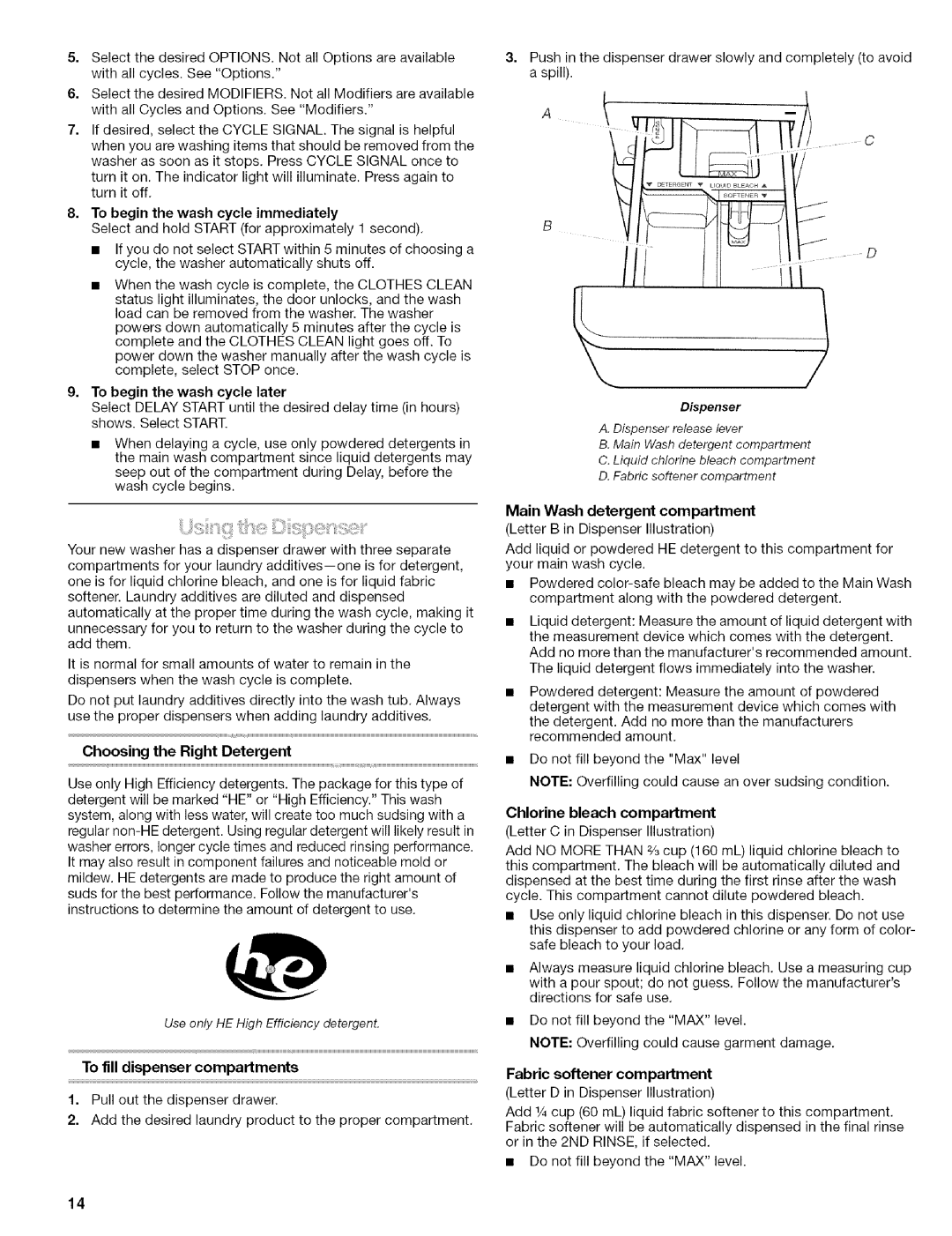
5.Select the desired OPTIONS. Not all Options are available with all cycles. See "Options."
6.Select the desired MODIFIERS. Not all Modifiers are available with all Cycles and Options. See "Modifiers."
7.If desired, select the CYCLE SIGNAL. The signal is helpful when you are washing items that should be removed from the washer as soon as it stops. Press CYCLE SIGNAL once to turn it on. The indicator light will illuminate. Press again to turn it off.
8.To begin the wash cycle immediately
Select and hold START (for approximately 1 second).
•If you do not select START within 5 minutes of choosing a cycle, the washer automatically shuts off.
•When the wash cycle is complete, the CLOTHES CLEAN status light illuminates, the door unlocks, and the wash load can be removed from the washer. The washer powers down automatically 5 minutes after the cycle is complete and the CLOTHES CLEAN light goes off. To power down the washer manually after the wash cycle is complete, select STOP once.
9.To begin the wash cycle later
Select DELAY START until the desired delay time (in hours) shows. Select START.
•When delaying a cycle, use only powdered detergents in the main wash compartment since liquid detergents may seep out of the compartment during Delay, before the wash cycle begins.
Your new washer has a dispenser drawer with three separate compartments for your laundry
It is normal for small amounts of water to remain in the dispensers when the wash cycle is complete.
Do not put laundry additives directly into the wash tub. Always use the proper dispensers when adding laundry additives.
Choosing the Right Detergent
Use only High Efficiency detergents. The package for this type of detergent will be marked "HE" or "High Efficiency." This wash system, along with less water, will create too much sudsing with a
regular
Use only HE High Efficiency detergenL
To fill dispenser compartments
1.Pull out the dispenser drawer.
2.Add the desired laundry product to the proper compartment.
3= Push in the dispenser drawer slowly and completely (to avoid
aspill).
A
Dispenser
A. Dispenser release lever
B. Main Wash detergent compartment
C. Liquid chlorine bleach compartment
D. Fabric softener compartment
Main Wash detergent compartment
(Letter B in Dispenser Illustration)
Add liquid or powdered HE detergent to this compartment for your main wash cycle.
•Powdered
•Liquid detergent: Measure the amount of liquid detergent with the measurement device which comes with the detergent. Add no more than the manufacturer's recommended amount. The liquid detergent flows immediately into the washer.
Powdered detergent: Measure the amount of powdered detergent with the measurement device which comes with the detergent. Add no more than the manufacturers recommended amount.
•Do not fill beyond the "Max" level
NOTE: Overfilling could cause an over sudsing condition.
Chlorine bleach compartment
(Letter C in Dispenser Illustration)
Add NO MORE THAN ¾ cup (160 mL) liquid chlorine bleach to this compartment. The bleach will be automatically diluted and dispensed at the best time during the first rinse after the wash cycle. This compartment cannot dilute powdered bleach.
•Use only liquid chlorine bleach in this dispenser. Do not use this dispenser to add powdered chlorine or any form of color- safe bleach to your load.
•Always measure liquid chlorine bleach. Use a measuring cup
with a pour spout; do not guess. Follow the manufacturer's directions for safe use.
•Do not fill beyond the "MAX" level.
NOTE: Overfilling could cause garment damage.
Fabric softener compartment
(Letter D in Dispenser Illustration)
Add 1/4cup (60 mL) liquid fabric softener to this compartment. Fabric softener will be automatically dispensed in the final rinse or in the 2ND RINSE, if selected.
•Do not fill beyond the "MAX" level.
14
